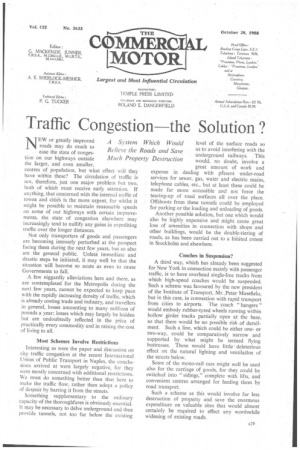Traffic Congestion the Solution ?
Page 31

If you've noticed an error in this article please click here to report it so we can fix it.
NEW may do much to EW or greatly improved ease the state of congestion on our highways outside the larger, and even smaller, centres of population, but what effect will they have within these? The circulation of traffic is not, therefore, just one major problem but two, both of which must receive early attention. If anything, that concerned with the internal traffic of towns and cities is the more urgent, for whilst it might be possible to maintain reasonable speeds on some of our highways with certain improvements, the state of congestion elsewhere may increasingly tend to nullify, any gains in expediting traffic over the longer distances.
Not only transporters of goods and passengers are becoming intensely perturbed at the prospect facing them during the next few years, but so also are the general public. Unless immediate and drastic steps be initiated, it may well he that the situation will become so acute as even to cause Governments to fall.
A few niggardly alleviations here and there, as are contemplated for the Metropolis during the next few years, cannot be expected to keep pace with the rapidly increasing density of traffic, which is already costing trade and industry, and travellers in general, losses amounting to many millions of pounds a year; losses which may largely be hidden but are undoubtedly reflected in the price of practically every commodity and in raising the cost of living to all.
Most Schemes Involve Restrictions Interesting as were the paper and discussion on city traffic congestion at the recent International Union of Public Transport in Naples, the conclusions arrived at were largely negative, for they were mostly concerned with additional restrictions. We must do something better than that here to make the traffic flow, rather than adopt a policy of despair by barring it from the streets.
Something supplementary to the ordinary capacity of the thoroughfares is obviously essential. It may be necessary to delve underground and thus provide tunnels, not too far below the existing level of the surface roads so as to avoid interfering with the underground railways. This would, no doubt, involve a great amount of work and expense in dealing with present under-road services for sewer, gas, water and electric mains, telephone cables, etc., but at least these could be made far more accessible and not •force the tearing-up of road surfaces all over the place. Offshoots from these tunnels could be _employed for parking or the loading and unloading of goods.
Another possible solution, but one which would also be highly expensive and might cause great loss of amenities in connection with shops and other buildings, would be the double-tiering of roads, as has been carried out to a lin-kited extent in Stockholm and elsewhere.
Coaches in Suspension?
A third way, which has already been suggested for New York in connection mainly with passenger traffic, is to have overhead single-line tracks from which high-speed coaches would be suspended. Such a scheme was favoured by the new president of the Institute of Transport, Mr. ,Peter Masefielu, but in this case, in connection with rapid transport from cities to airports. The coach " hangers " would embody rubber-tyred wheels running within hollow girder tracks partially open at the base, so that there would be no possible risk of derailment. Such a line, which could be either oneor two-way, could be comparatively narrow and supported by what might be termed flying buttresses. These would have little ' deleterious effect on the natural lighting and ventilation of the streets below.
Some of the mono-rail cars might well be used also for the carriage of goods, for they could be switched into "sidings," complete with lifts, and convenient centres arranged for feeding them by road transport.
Such a scheme as this would involve far less destruction of property and save the enormous expenditure on valuable sites that would almost certainly be required to effect any worthwhile widening of existing roads.




































































































